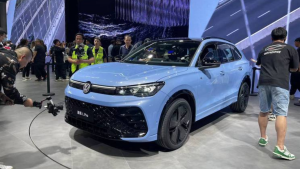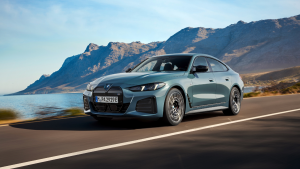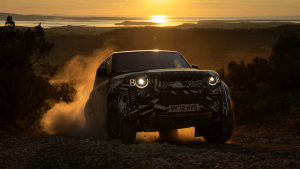Mini Countryman driven
You might have been surprised by the Mini that is having its first 'testing' season in the World Rally Championship. Red with a white roof, it purposely recalls the successful Mini-Cooper S rally cars of the 1960s and Paddy Hopkirk, one of the most famous drivers of that era, has been promoting the marque's return to international rallying.
If you have seen a picture of the old and new together you will realize that the situation is not quite as it seems. The Mini launched as a BMW sub-brand in 2001 brazenly wore the mantle of the 40 years-old original but actually had no relationship with it other than the name, handed down through a series of company mergers and takeovers.
The original Mini, as designed by Alec Issigonis for the British Motor Corporation, was a masterpiece of packaging, a car 3.05m long that could accommodate four people in reasonable comfort. BMW's follow up was 3.6 m and a conventional modern hatchback with limited rear seat and luggage space. Though it has sharp handling and a sporty performance, its success is down to clever marketing. Today's Mini is an automotive fashion item.
The new Mini is now in its second generation and along the way spawned some tricksy derivatives â" an impractical convertible and a curious Clubman estate version with two doors on one side and one on the other. Now there is a fourth member of the family, the Countryman and, at 4.1m, it ought really to be called the Maxi. Enough people remembered that British Leyland used that name in the 1970s for a spacious but flawed five-door hatchback and BMW didn't want to risk the association. Besides, it reminds us, Mini is now a brand in its own right and has nothing to do with size.
Making a Mini the size of a VW Golf presented new opportunities. It provided a model that existing Mini owners could move up to as their families expanded. Giving it a tall stance and generous ground clearance did nothing for its looks but, with optional four-wheel drive, meant that it could compete with the 'soft roader' SUVs. And it also presented a suitable platform for a WRC contender.
Enter David Richards, chairman of Aston Martin and proprietor of Prodrive, race and rally car preparation specialists. When the FIA announced the new rules for WRC starting in 2011, Prodrive set about designing the optimum car, from drive-line to its suspension and component layout. The idea was that it could provide a ready-made rally contender for any manufacturer with a suitably-sized production model. Mini wanted to go rallying and the Countryman was the right starting point.
You won't find the name Countryman on the cars that made their debut in the Rally d'Italia in Sardinia in May. In an attempt to link with the hottest performance versions of all their models, the official Prodrive rally cars called Mini John Cooper Works WRC.
Richards is confident that these cars can be winners in the WRC next year. He praises the special 1.6-litre turbocharged direct injection engines provided by BMW Motorsport admits that the only disadvantage of the Countryman bodyshell is its height. He looks forward to a two-door version like the Paceman concept car which will be in production in 2013.
Needless to say, in technical specification and performance, the rally cars bear no comparison with the production model. Nonetheless, BMW chose to base the introduction of the Countryman at a race circuit, the Bedford Autodrome complex owned by ex-Formula 1 driver Jonathan Palmer.
It didn't take long to work out why. In a short drive in the four-wheel drive 184bhp Countryman Cooper S All-4 around the country lanes of Bedfordshire we found it to have such hard and unyielding suspension that it was not only uncomfortable but limited in performance because it was so badly deflected by bumps. On the smooth track it was a different story: fast, responsive and far more composed than might be expected of a car with the height of an SUV. Better then, for regular use, to go for one of the less extreme versions which start with the 90bhp 1.6-litre diesel and include a Cooper with a 122bhp petrol engine. Recently, a 143bhp 2-litre diesel has been introduced across the Mini range and it was this new Countryman Cooper SD All-4 that we used for a more extensive test.
SD is supposed to stand for 'sports diesel' and it is an attempt to reconcile Mini's sporty image â" and WRC programme â" with customer demand for diesel engines. Diesel versions of the smaller Minis are a somewhat specialized purchase but they form a large part of the market sector where the Countryman finds itself.
The SD has the largest displacement engine of any Mini and it produces the most torque â" 305Nm from 1,750rpm. But it is also the heaviest Mini (at nearly 1,400kg) and to give it good fuel consumption it is very high-geared. So it is neither especially fast, nor notably flexible. Claimed figures are 0-100 kmph in 9.5seconds, a maximum speed of 195kmph and a combined fuel cycle fuel consumption of 20kmpl. Driver aids for fuel economy include an indicator to tell you to change up or down â" the high gearing shows itself when it requires a downshift from sixth to fifth at a steady 60kmph. An infuriatingly lazy stop-start system is standard; fortunately, it can be turned off.
The four-wheel drive system, in which a clutch pack engages the rear wheels when front wheel slip is detected, works unobtrusively. Grip from its substantial 225/45 18 tyres is not a problem but the too-stiff suspension is, creating instability and an uncomfortable ride on a bumpy road.
The Countryman SD All-4 begs comparison with the Range Rover Evoque which is not only better looking but more competent overall. On paper it looks cheaper than the baby Range Rover but with the options fitted to the test car â" leather seats, glass double sunroof, navigation system and fancy wheels and stereo â" the Mini price almost touches Rs 20 lakh.
The highly stylised interior, with a huge dinner-plate speedometer and display screen at the centre of the dash, follows lesser Minis. The Countryman can be ordered with five seats or â" better â" four individual chairs. There is room enough for large adults to sit in comfort, front and rear.
You will have gathered that we are not very impressed by the biggest Mini but UK customers don't share our reservations. The Countryman is already a sales success, which shows the brilliance of Mini's marketing plan: over 10 years, buyers have got to like and trust the brand. Now BMW hopes that success in rallying will attract a new generation of Mini enthusiasts.
Starts Rs 39.5 Lakhs
1998cc
Automatic
192
280
14.34 Kmpl
Related Stories
Top Stories
Latest Videos
Most Popular
- Budget Sportbike Showdown: Kawasaki Ninja 500 vs Aprilia RS 457 vs Yamaha YZF-R3
- 2014 Triumph Daytona 675 vs 2024 Kawasaki ZX6R - A Decade of Evolution in Supersport Motorcycles
- Mumbai-Pune Expressway speed restrictions updated
- Nissan Magnite EZ-Shift review - is the AMT any good?
- Nitin Gadkari states that tax on Hybrids should be reduced to 12 percent in the coming future











